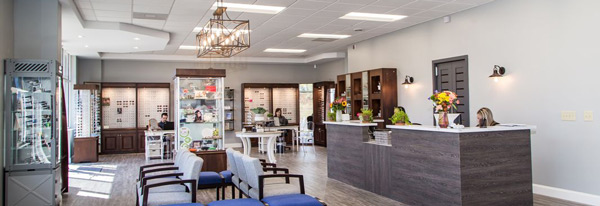It’s back-to-school season! As a parent, you know that your child needs all of the tools and resources available to be successful in the classroom, on the athletic field, and at social events — as well as to maintain a positive self-image. Did you know that along with their changing bodies, a child’s vision can change as they grow and mature?
Scholastically, the demands of learning change as well. Print size grows smaller, assignments lengthen, and the amount of time devoted to screen time, reading, and writing increases. And not just in the classroom; this also extends to homework assignments. Good vision includes not only the ability to see clearly, but also the key that unlocks reading comprehension — understanding the meaning and content of the written word.
August is Vision and Learning Month, because there is a strong correlation between scholastic success and healthy vision. In our practice, we ensure that every child we see goes back to class with the advantage of their best possible vision so they can ace the school year ahead.
In our optometry practice, we often talk with concerned parents who have questions about the visual behaviors they see in their child. Some of these may correlate with noticeable changes in their student’s comprehension and skills.
5 Concerns Parents Share With Us
Following are 5 statements we commonly hear from parents. Do any of these questions sound like the concerns, problems, or behavioral changes you have seen in your children?
- “I have noticed that my child is squinting, rubbing their eyes, and losing their place on the page when reading — but the school vision screening did not identify any issues.”
According to the American Optometric Association, one in four school-age children has a vision disorder. However, school vision screenings miss up to 75% of children with vision problems. This is in part because school screenings do not test all causes of potential vision problems. Parents and educators sometimes assume — incorrectly — that if a child passes a school screening test that the student has no vision issues. However, 20/20 vision is only a measure of visual acuity, which means seeing clearly at varying distances. It does not test your student’s ability to perform the critical functions listed below:
- Eye Focusing: Necessary when focusing on a chalkboard, then looking back to the printed page, then back again to the chalkboard
- Eye Teaming: Both eyes working smoothly together as they move across a page
- Eye Hand Coordination: The visual information and perception that directs hand movement, such as in sports and driving
- Visual Perception: Organizing and decoding information into words and ideas and having the ability to comprehend that information
- “My child was previously an excellent athlete but now struggles to achieve what she was always able to do with great success. It seems she isn’t able to judge the distance of the ball and make contact.”
A change in athletic ability could certainly be caused by a change in your child’s visual perception. It could be undiagnosed Eye Hand Coordination or Eye Teaming issues, or any number of eye insufficiencies that may change her ability to perform. A comprehensive eye exam with your optometrist will test for all functional vision issues. Our practice offers student athletes the option of prescription goggles to correct their vision and protect their eyes as they compete.
- “My child has been identified as being ADHD. Could vision problems contribute to that?”
Many children are misdiagnosed with behavioral issues such as ADHD, learning disabilities or dyslexia. Such labels can, unfortunately, stay with your student into adulthood and negatively impact their self-esteem. Learning challenges can have their basis in vision problems. Undetected vision issues sometimes share symptoms of ADHD in students. If a vision issue is the root cause of your child’s issues, it’s quite possible that it can be addressed with proper diagnosis and corrective eyewear.
Schedule a comprehensive eye exam for your student today to diagnose any visual issues that may be masquerading as other challenges. The sooner your child is correctly diagnosed, the less likely that an incorrect behavioral diagnosis will impact them for years to come.
- “I’m not sure my child will wear her glasses. How do I get her to wear them?”
We understand your concern! In our practice, we find that children who choose their favorite color, shape, or style of frame do quite well with wearing their corrective lenses. Our opticians are great with kids and can help them make a choice that you’ll like, too. Once your child wears his or her glasses a few times and no longer struggles with their vision, they will be more likely to wear their glasses regularly.
- “My child doesn’t complain about not being able to see clearly.”
Children grow accustomed to the only vision they “know.” They don’t realize that they have a vision problem because they have had no other vision for comparison. In other words, “They don’t know what they don’t know.” Lacking such an integral skill as good vision will force your student to work harder in school, and they may lose interest or become so frustrated that they give up altogether. This may adversely affect their self-esteem because they will see themselves as unable to grasp what other children are learning with ease.
Bottom line? As a parent, you rightly have concerns about how well your child will do in school. While some things are beyond your control, scheduling a comprehensive eye exam is a relatively easy way to gain peace of mind.
Call our office today to schedule a back-to-school appointment. We’ll make sure your student is seeing their best to give them the best possible chance for a successful school year!


